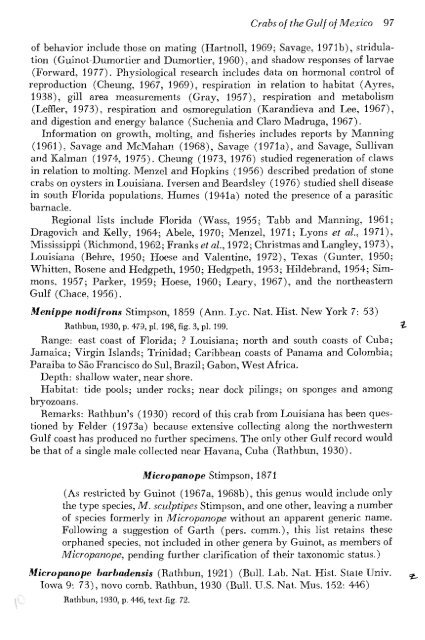You also want an ePaper? Increase the reach of your titles
YUMPU automatically turns print PDFs into web optimized ePapers that Google loves.
Crabs of the Gulf of Mexico 97<br />
of behavior include those on mating (Flartnoll, 1969; Savage, 1971b), stridulation<br />
(Guinot-Dumortier and Dumortier, 1960), and shadow responses of larvae<br />
(Forward, 1977). Physiological research includes data on hormonal control of<br />
reproduction (Cheung, 1967, 1969), respiration in relation to habitat (A3a'es,<br />
1938), gill area measurements (Gray, 1957), respiration and metabolism<br />
(Leffler, 1973), respiration and osmoregulation (Karandieva and Lee, 1967),<br />
and digestion and energjr balance (Suchenia and Claro Madruga, 1967).<br />
Information on growth, molting, and fisheries includes reports by Manning<br />
(1961), Savage and McMahan (1968), Savage (1971a), and Savage, Sullivan<br />
and Kalman (1974, 1975). Cheung (1973, 1976) studied regeneration of claws<br />
in relation to molting. Menzel and Hopkins (1956) described predation of stone<br />
crabs on oysters in Louisiana. Iversen and Beardsley (1976) studied shell disease<br />
in south Florida populations. Humes (1941a) noted the presence of a parasitic<br />
barnacle.<br />
Regional lists include Florida (Wass, 1955; Tabb and Manning, 1961;<br />
Dragovich and Kelly, 1964; Abele, 1970; Menzel, 1971; Lyons et al., 1971),<br />
Mississippi (Richmond, 1962; Franks et al., 1972; Christmas and Langley, 1973),<br />
Louisiana (Behre, 1950; Hoese and Valentine, 1972), Texas (Gunter, 1950;<br />
Whitten, Rosene and Hedgpeth, 1950; Hedgpeth, 1953; Hildebrand, 1954; Simmons,<br />
1957; Parker, 1959; Hoese, I960; Leary, 1967), and the northeastern<br />
Gulf (Chace, 1956).<br />
Menippe nodifrons Stimpson, 1859 (Ann. Lye. Nat. Hist. New York 7: 53)<br />
Rathbun, 1930, p. 479, pi. 198, fig. 3, pi. 199.<br />
Range: east coast of Florida; ? Louisiana; north and south coasts of Cuba;<br />
Jamaica; Virgin Islands; Trinidad; Caribbean coasts of Panama and Colombia;<br />
Paraiba to Sao Francisco do Sul, Brazil; Gabon, West Africa.<br />
Depth: shallow water, near shore.<br />
Habitat: tide pools; under rocks; near dock pilings; on sponges and among<br />
brji-Qzoans.<br />
Remarks: Rathbun's (1930) record of this crab from Louisiana has been questioned<br />
by Felder (1973a) because extensive collecting along the northwestern<br />
Gulf coast has produced no further specimens. The only other Gulf record would<br />
be that of a single male collected near Havana, Cuba (Rathbun, 1930).<br />
Micropanope Stimpson, 1871<br />
(As restricted by Guinot (1967a, 1968b), this genus would include only<br />
the type species, M. sculptipes Stimpson, and one other, leaving a number<br />
of species formerly in Micropanope without an apparent generic name.<br />
Following a suggestion of Garth (pers. comm.), this list retains these<br />
orphaned species, not included in other genera by Guinot, as members of<br />
Micropanope, pending further clarification of their taxonomic status.)<br />
Micropanope barbadensis (Rathbun, 1921) (Bull. Lab. Nat. Hist. State Univ.<br />
Iowa 9: 73), novo comb. Rathbun, 1930 (Bull. U.S. Nat. Mus. 152: 446)<br />
iO Rathbun, 1930, p. -M-G, text-fig. 72.

















